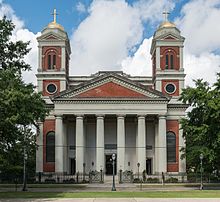Cathedral Basilica of the Immaculate Conception, Mobile
| Cathedral Basilica of the Immaculate Conception |
|
|---|---|
 |
|
| 30°41′24″N 88°02′45″W / 30.69000°N 88.04583°WCoordinates: 30°41′24″N 88°02′45″W / 30.69000°N 88.04583°W | |
| Location | 2 South Claiborne Street Mobile, Alabama |
| Country | United States |
| Denomination | Roman Catholic Church |
| Website | www |
| History | |
| Founded | 1703 |
| Founder(s) | Most Rev. Michael Portier |
| Architecture | |
| Architect(s) | Claude Beroujon |
| Style | Greek Revival |
| Groundbreaking | 1835 |
| Completed | 1850 |
| Specifications | |
| Number of spires | Two |
| Materials | Brick |
| Administration | |
| Archdiocese | Archdiocese of Mobile |
| Clergy | |
| Archbishop | Most Rev. Thomas J. Rodi |
| Rector | Rev. Stephen E. Martin |
The Cathedral Basilica of the Immaculate Conception is a cathedral serving Roman Catholics in the U.S. city of Mobile, Alabama. It is the seat of the Archbishop of the Roman Catholic Archdiocese of Mobile. The cathedral is named for Mary, mother of Jesus, under her title, Our Lady of the Immaculate Conception. It is listed on the National Register of Historic Places as a contributing property to the Church Street East Historic District and is listed on the Historic Roman Catholic Properties in Mobile Multiple Property Submission
Mobile’s Cathedral Parish was established on July 20, 1703, by Jean-Baptiste de la Croix de Chevrières de Saint-Vallier, Bishop of Quebec. Bishop de Saint-Vallier named Father Roulleaux de La Vente, first pastor of the parish church, which was located at the French settlement of Mobile at the citadel of Fort Louis de la Louisiane. The parish is the first established on the Gulf Coast.
When the Mobile settlement was relocated to its present site in 1711, a new parish church was built and was known as Notre Dame de la Mobile (Our Lady of Mobile). In 1781, during the Spanish occupation of Mobile, the parish took its current name, Immaculate Conception.
Mobile was elevated to a diocese in 1829, and Frenchman, Michael Portier, was named its first bishop. Bishop Portier’s first “cathedral” was a small wooden structure located in the Old Spanish Burying Ground, site of the present cathedral. Portier soon set out to construct a "real" cathedral.
...
Wikipedia
